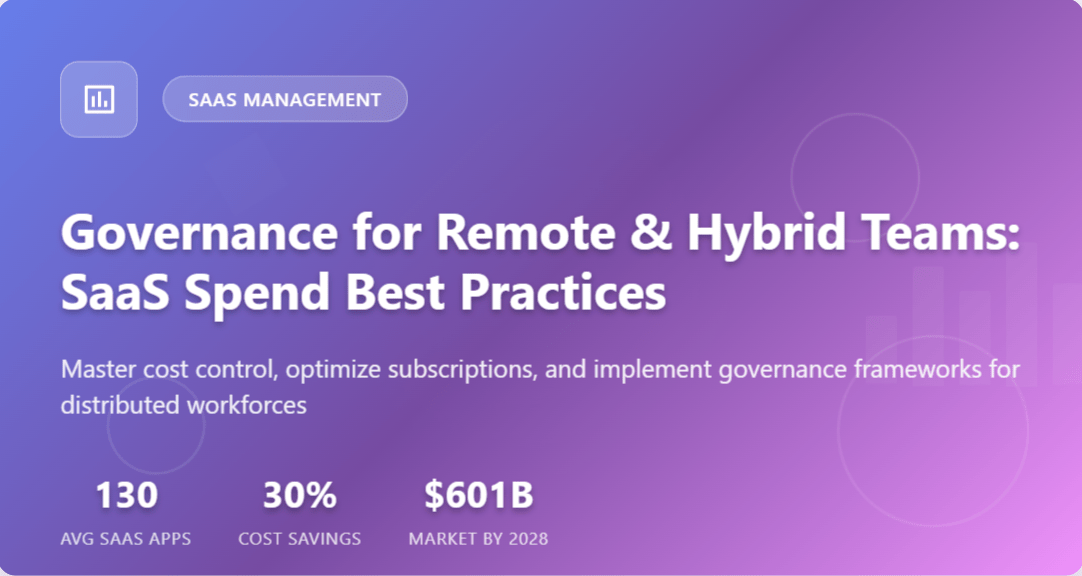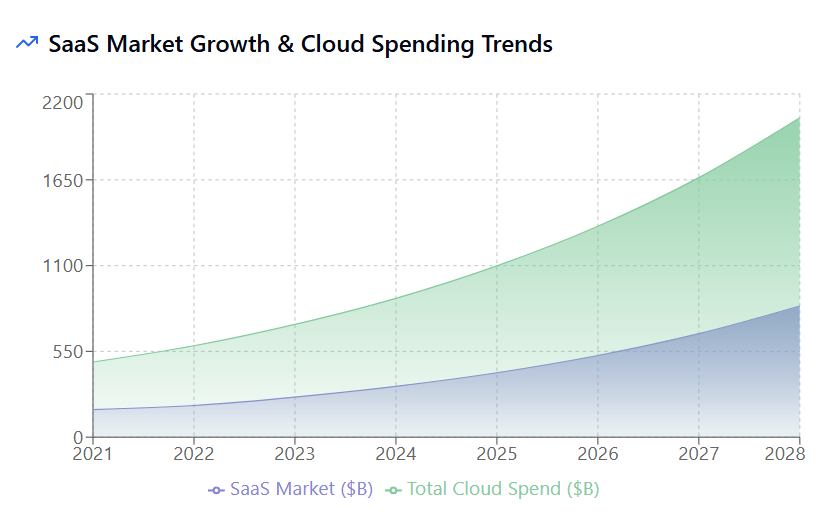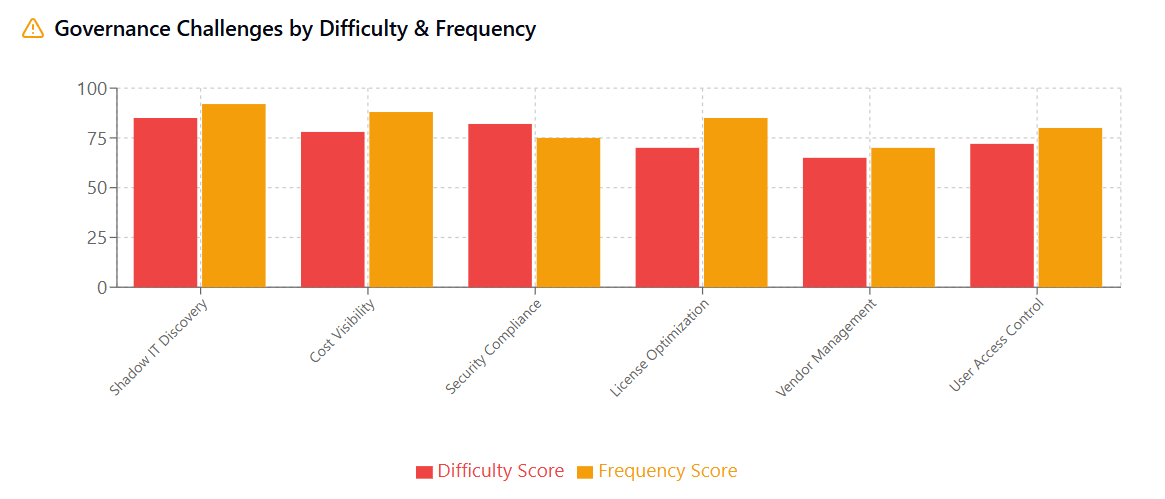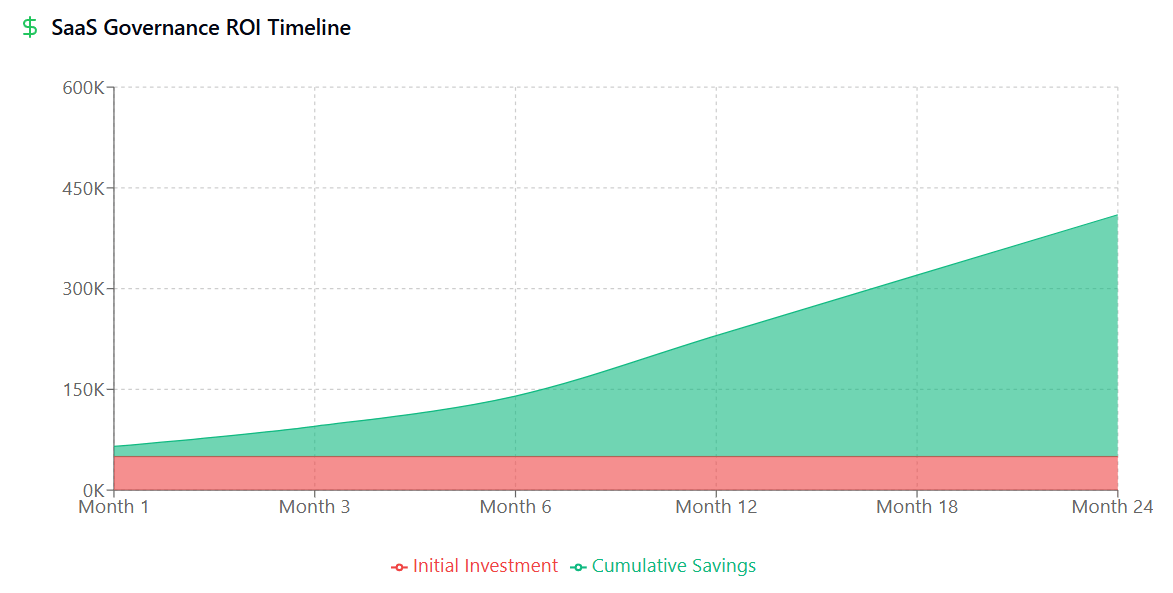
The transition to remote and hybrid work models has fundamentally transformed how organizations approach software procurement and management. As distributed teams increasingly rely on diverse SaaS solutions to maintain productivity and collaboration, the need for robust governance frameworks has become more critical than ever. Organizations now face the complex challenge of managing dozens or even hundreds of software subscriptions across multiple departments, locations, and currencies while ensuring cost efficiency and maintaining security standards.
This shift has created a perfect storm of SaaS sprawl, where teams independently adopt applications without centralized oversight, leading to duplicate subscriptions, underutilized licenses, and escalating costs. The traditional approach of centralized IT procurement simply cannot keep pace with the rapid adoption requirements of distributed teams, necessitating new governance models that balance agility with control.
This comprehensive guide addresses these challenges by providing actionable strategies for implementing effective SaaS governance in remote and hybrid environments. We’ll explore proven methodologies for controlling costs, optimizing subscriptions, and establishing governance policies that support both productivity and financial responsibility. Whether you’re managing a fully remote startup or a hybrid enterprise, these best practices will help you harness the power of SaaS while maintaining fiscal discipline and operational efficiency.
The Remote Work Revolution and SaaS Proliferation
The global shift to remote and hybrid work models has accelerated SaaS adoption at an unprecedented rate. According to recent industry data, organizations now use an average of 130 SaaS applications, a 30% increase from pre-pandemic levels. This explosive growth reflects the fundamental change in how teams collaborate, communicate, and execute their work in distributed environments.
Remote teams require specialized tools for video conferencing, project management, document collaboration, time tracking, and team communication. Each department often has unique requirements, leading to the adoption of vertical-specific solutions for HR, finance, marketing, and customer support. While this diversity of tools enables productivity and specialization, it also creates significant governance challenges.
The distributed nature of remote teams means that traditional IT gatekeeping becomes less effective. Team leads and individual contributors often identify and adopt new SaaS solutions independently, creating shadow IT environments that operate outside organizational oversight. This decentralized adoption model, while enabling agility and responsiveness, can result in substantial cost inefficiencies and security risks.
Moreover, the subscription-based nature of most SaaS solutions means that costs accumulate continuously, making it essential to implement proactive governance measures. Unlike traditional software purchases with one-time costs, SaaS subscriptions represent ongoing financial commitments that can quickly spiral out of control without proper oversight.
The complexity increases further when considering multi-currency operations, varying subscription terms, different billing cycles, and the challenge of tracking actual usage across distributed teams. Organizations must balance the need for team autonomy with the requirement for cost control and risk management.

Understanding SaaS Governance in Distributed Teams
SaaS governance for remote and hybrid teams encompasses the policies, processes, and technologies used to oversee software procurement, deployment, usage, and optimization across distributed workforces. Unlike traditional IT governance models that rely heavily on centralized control, modern SaaS governance must accommodate the decentralized nature of remote work while maintaining appropriate oversight and cost discipline.
Effective SaaS governance addresses several critical dimensions. Financial governance focuses on controlling costs, optimizing subscriptions, and ensuring budget compliance across departments and geographies. Operational governance ensures that SaaS applications align with business objectives and integrate effectively with existing workflows. Security governance maintains data protection and compliance standards across all adopted platforms.
The governance framework must also account for the unique characteristics of remote teams, including varying time zones, different local regulations, diverse technical capabilities, and the need for self-service access to tools and resources. This requires a more flexible and adaptive approach compared to traditional centralized IT management.
Successful SaaS governance in distributed environments relies on establishing clear roles and responsibilities, implementing automated monitoring and control mechanisms, and creating transparent communication channels between teams and central oversight functions. The goal is to enable teams to access the tools they need while providing visibility and control to organizational leadership.
The governance model should also accommodate the dynamic nature of SaaS usage, where application needs can change rapidly based on project requirements, team composition, and business priorities. This requires implementing processes that can quickly adapt to changing requirements while maintaining cost discipline and operational efficiency.
Key Challenges in Remote SaaS Management
Remote and hybrid teams face unique challenges in managing SaaS subscriptions and maintaining governance. The distributed nature of these teams amplifies traditional SaaS management difficulties while introducing new complexities specific to remote work environments.
Visibility and Discovery Challenges
One of the primary challenges is maintaining comprehensive visibility into all SaaS subscriptions across distributed teams. Remote employees often procure applications independently using personal credit cards or departmental budgets, creating shadow IT environments that remain invisible to central management. This lack of visibility makes it impossible to identify redundant subscriptions, track actual usage, or negotiate volume discounts effectively.
Cost Control and Budget Management
Managing SaaS costs across distributed teams involves tracking subscriptions in multiple currencies, managing different billing cycles, and allocating costs across various departments and projects. Remote teams may lack awareness of organizational budget constraints or available alternatives, leading to suboptimal purchasing decisions and cost escalation.
Security and Compliance Risks
Each independently adopted SaaS application represents a potential security risk, particularly when proper vetting and integration processes are bypassed. Remote teams may not have the expertise to evaluate security controls, data handling practices, or compliance requirements, potentially exposing the organization to data breaches or regulatory violations.
Integration and Workflow Disruption
The proliferation of disparate SaaS tools can create workflow inefficiencies and data silos. Remote teams may adopt solutions that don’t integrate well with existing systems, leading to manual data transfer, duplicate data entry, and reduced overall productivity.
User Management and Access Control
Managing user access across multiple SaaS platforms becomes increasingly complex with distributed teams. Onboarding new team members, managing role changes, and ensuring proper offboarding requires coordination across numerous applications, increasing administrative overhead and security risks.
License Optimization and Utilization
Remote teams often struggle to accurately assess their actual software needs, leading to over-provisioning of licenses or adoption of feature-rich plans that exceed requirements. Without proper usage monitoring, organizations may continue paying for underutilized or abandoned subscriptions.

Essential SaaS Governance Framework
Implementing effective SaaS governance for remote and hybrid teams requires a comprehensive framework that addresses policy development, process implementation, and technology deployment. This framework should be designed to provide appropriate oversight while enabling team autonomy and maintaining operational efficiency.
Governance Policies and Standards
The foundation of effective SaaS governance lies in establishing clear policies that define acceptable use, procurement processes, security requirements, and cost management principles. These policies should address both mandatory requirements and recommended best practices, providing teams with clear guidance while maintaining flexibility for legitimate business needs.
Procurement policies should define approval thresholds, evaluation criteria, and preferred vendor relationships. Security policies must establish minimum standards for data protection, access controls, and integration requirements. Cost management policies should set budget limits, define spending approval processes, and establish guidelines for subscription optimization.
Organizational Structure and Roles
Successful SaaS governance requires clearly defined roles and responsibilities across the organization. This typically includes establishing a cloud cost management team or SaaS governance committee with representatives from IT, finance, procurement, and major business units.
The governance structure should designate SaaS champions within each department who can serve as liaisons between their teams and central governance functions. These individuals can help evaluate new requirements, facilitate adoption of approved solutions, and provide feedback on policy effectiveness.
Risk Management and Compliance
The governance framework must address various risk categories, including financial risks from cost overruns, operational risks from application failures or poor integration, and security risks from inadequate data protection. This requires implementing risk assessment processes, establishing monitoring mechanisms, and defining incident response procedures.
Compliance requirements vary by industry and geography, necessitating processes to evaluate and monitor compliance across all adopted SaaS platforms. This includes data residency requirements, regulatory reporting obligations, and industry-specific security standards.
Change Management and Communication
Implementing SaaS governance in existing remote teams requires careful change management to ensure adoption and compliance. This involves communicating the benefits of governance, providing training on new processes, and establishing feedback mechanisms to continuously improve the framework.
Regular communication about governance policies, approved vendors, cost optimization opportunities, and security requirements helps maintain awareness and compliance across distributed teams.
SaaS Spend Management Strategies
Effective SaaS spend management for remote and hybrid teams requires implementing multiple complementary strategies that address different aspects of cost control and optimization. These strategies must be designed to work effectively across distributed teams while providing centralized visibility and control.
Centralized Procurement and Vendor Management
Establishing centralized procurement processes helps organizations negotiate better terms, avoid duplicate subscriptions, and maintain vendor relationships more effectively. This doesn’t necessarily mean all purchases must go through a central team, but rather that major vendors and enterprise agreements are managed centrally while providing guidelines and preferred options for team-level procurement.
Vendor management involves maintaining relationships with key SaaS providers, negotiating enterprise agreements, and establishing preferred vendor lists that balance functionality, cost, and security requirements. This approach enables teams to make informed decisions while leveraging organizational buying power.
Subscription Optimization and Rightsizing
Regular review and optimization of SaaS subscriptions ensures that organizations pay only for needed capabilities and user counts. This involves analyzing usage patterns, identifying underutilized licenses, and adjusting subscription levels based on actual requirements.
Rightsizing strategies include downgrading plans with excessive features, reducing user counts for inactive accounts, and negotiating custom pricing for high-volume usage. Organizations should implement regular review cycles to ensure subscriptions remain aligned with actual needs.
Usage Monitoring and Analytics
Implementing comprehensive usage monitoring provides the data necessary for informed optimization decisions. This involves tracking login frequency, feature utilization, data usage, and user engagement across all SaaS platforms.
Analytics capabilities enable organizations to identify trends, predict future needs, and make data-driven decisions about subscription changes. This information is particularly valuable for SaaS management tools that can automate much of the monitoring and analysis process.
Cost Allocation and Chargeback
Implementing cost allocation mechanisms helps departments understand their SaaS spending and creates accountability for optimization decisions. This can involve direct allocation based on usage, shared cost distribution, or chargeback models that bill departments for their actual consumption.
Chargeback models are particularly effective for creating cost awareness and encouraging optimization behaviors. When teams are directly responsible for their SaaS costs, they are more likely to evaluate needs carefully and optimize their subscriptions proactively.
Budget Management and Controls
Establishing budget controls helps prevent cost overruns while providing teams with appropriate spending flexibility. This can involve setting departmental budgets, implementing approval workflows for large purchases, and establishing automated alerts for unusual spending patterns.
Budget management should balance control with agility, ensuring that teams can access needed tools quickly while maintaining overall cost discipline. Pre-approved vendor lists and spending thresholds can help achieve this balance.
Implementation Best Practices
Successfully implementing SaaS governance for remote and hybrid teams requires following proven best practices that address the unique challenges of distributed work environments. These practices should be adapted to organizational culture, team structure, and business requirements while maintaining core governance principles.
Start with Discovery and Assessment
Before implementing governance controls, organizations must understand their current SaaS landscape. This involves conducting comprehensive discovery to identify all existing subscriptions, usage patterns, cost structures, and risk exposures. Discovery tools can automate much of this process, but may require integration with financial systems, identity providers, and network monitoring tools.
The assessment should evaluate each application’s business value, security posture, integration requirements, and cost effectiveness. This information provides the foundation for developing governance policies and optimization strategies.
Implement Gradually with Pilot Programs
Rather than implementing comprehensive governance controls across the entire organization simultaneously, successful implementations typically use pilot programs to test approaches and refine processes. Starting with willing departments or specific application categories allows organizations to learn and adjust before broader deployment.
Pilot programs should include representatives from various team types and geographic locations to ensure that governance approaches work effectively across the distributed workforce. Feedback from pilot participants is essential for refining policies and processes.
Establish Clear Communication Channels
Effective governance requires ongoing communication between distributed teams and central governance functions. This involves establishing regular communication cadences, creating feedback mechanisms, and providing clear channels for requesting approvals or reporting issues.
Communication should be bidirectional, with central teams providing updates on policies and approved vendors while receiving feedback on requirements and challenges from distributed teams. Regular governance reviews and team meetings help maintain alignment and address emerging issues.
Provide Self-Service Tools and Resources
Remote teams value autonomy and quick access to needed resources. Providing self-service tools for common governance activities reduces administrative overhead while maintaining appropriate controls. This can include approved vendor catalogs, automated approval workflows, and self-service provisioning for standard applications.
Self-service resources should include guidance on evaluation criteria, security requirements, and cost optimization opportunities. Making this information easily accessible helps teams make better decisions independently.
Monitor and Measure Continuously
Governance effectiveness requires ongoing monitoring of key metrics including cost trends, compliance rates, security incidents, and user satisfaction. Automated monitoring tools can provide real-time visibility into subscription changes, usage patterns, and potential issues.
Regular reporting and review cycles help identify areas for improvement and ensure that governance processes remain aligned with business objectives. Key performance indicators should include both financial metrics and operational effectiveness measures.
Technology Solutions for SaaS Governance
Implementing effective SaaS governance at scale requires leveraging technology solutions that can automate monitoring, provide centralized visibility, and enforce policy compliance across distributed teams. These solutions should integrate with existing business systems while providing the flexibility needed for diverse team requirements.
SaaS Management Platforms
Comprehensive SaaS management platforms provide centralized visibility and control across an organization’s entire SaaS portfolio. These platforms typically offer discovery capabilities, cost monitoring, usage analytics, and optimization recommendations. Leading solutions can integrate with financial systems, identity providers, and individual SaaS applications to provide comprehensive oversight.
Key capabilities include automated subscription discovery, usage tracking, cost allocation, renewal management, and compliance monitoring. Advanced platforms also provide predictive analytics, optimization recommendations, and automated policy enforcement.
Identity and Access Management Integration
Integrating SaaS governance with identity and access management (IAM) systems provides better control over user provisioning, access rights, and offboarding processes. This integration enables automated user lifecycle management across multiple SaaS platforms while maintaining security and compliance standards.
IAM integration also provides valuable usage data, helps identify inactive accounts, and enables more accurate license optimization. Single sign-on (SSO) capabilities can improve user experience while providing better visibility into application access patterns.
Financial Management Integration
Connecting SaaS governance tools with financial management systems enables automated cost tracking, budget monitoring, and reporting. This integration provides finance teams with better visibility into SaaS spending while enabling automated controls and alerts.
Integration capabilities should include accounts payable matching, cost center allocation, and budget variance reporting. Advanced integrations can also provide predictive cost modeling and optimization recommendations based on usage trends and contract terms.
Workflow and Approval Automation
Automated workflow tools can streamline procurement processes while maintaining appropriate governance controls. These tools can implement approval workflows, enforce policy compliance, and provide audit trails for governance activities.
Workflow automation should accommodate the distributed nature of remote teams while providing appropriate oversight and control. This includes mobile-friendly interfaces, flexible approval chains, and integration with collaboration tools commonly used by remote teams.
Analytics and Reporting Capabilities
Comprehensive analytics and reporting capabilities provide the insights necessary for effective governance decision-making. These tools should provide both operational dashboards for day-to-day management and strategic reports for executive oversight.
Analytics capabilities should include usage trending, cost optimization opportunities, security risk assessment, and compliance monitoring. Reporting should be flexible enough to support different stakeholder needs while providing consistent and accurate information.
Measuring Success and ROI
Measuring the success of SaaS governance initiatives requires establishing clear metrics that demonstrate both financial and operational benefits. These metrics should align with organizational objectives while providing actionable insights for continuous improvement.
Financial Metrics and Cost Optimization
The most direct measure of governance success is cost reduction and optimization. Key financial metrics include total SaaS spending trends, cost per user, subscription utilization rates, and savings from optimization activities. Organizations should track both immediate cost reductions and long-term cost avoidance from improved procurement processes.
Cost optimization metrics should also include vendor consolidation benefits, volume discount achievements, and reduced administrative overhead. Tracking these metrics helps demonstrate the financial value of governance investments while identifying areas for additional optimization.
Operational Efficiency Improvements
Governance initiatives should improve operational efficiency through reduced administrative overhead, faster procurement cycles, and better tool utilization. Metrics should include time-to-provision for new applications, user satisfaction scores, and reduction in IT support tickets related to SaaS issues.
Operational metrics should also measure the effectiveness of self-service capabilities, accuracy of cost allocation, and compliance with governance policies. These metrics help ensure that governance improvements don’t come at the expense of team productivity or satisfaction.
Risk Reduction and Compliance
Effective governance should reduce various risk categories while improving compliance posture. Security metrics include the number of unauthorized applications, security incidents related to SaaS platforms, and compliance assessment scores. Financial risk metrics include budget variance, unexpected cost escalations, and contract compliance rates.
Risk reduction should be measured both quantitatively through incident rates and qualitatively through assessment of overall risk posture. Compliance metrics should align with relevant regulatory requirements and industry standards.
User Adoption and Satisfaction
Governance success depends on user adoption and satisfaction with implemented processes and tools. Metrics should include policy compliance rates, utilization of approved vendors, and user satisfaction surveys. High compliance rates combined with positive user feedback indicate effective governance implementation.
User adoption metrics should also measure engagement with self-service tools, participation in governance processes, and feedback quality. These metrics help identify areas where governance processes may need refinement or additional training.
Long-term Strategic Benefits
Beyond immediate operational and financial benefits, successful governance should provide strategic advantages including improved vendor relationships, better negotiating positions, and enhanced ability to scale operations. These benefits may be more difficult to quantify but are essential for long-term success.
Strategic metrics might include vendor satisfaction scores, time-to-market for new initiatives requiring SaaS tools, and organizational agility in responding to changing business requirements. These metrics help demonstrate the broader value of governance investments.

Future-Proofing Your SaaS Governance
As remote and hybrid work models continue to evolve, SaaS governance frameworks must adapt to address emerging trends, technologies, and business requirements. Future-proofing governance initiatives requires anticipating changes and building flexibility into governance processes and technology solutions.
Emerging Technology Integration
Artificial intelligence and machine learning technologies are increasingly being integrated into SaaS platforms, creating new capabilities but also new governance challenges. AI-powered analytics can provide better insights into usage patterns and optimization opportunities while also raising questions about data privacy and algorithmic transparency.
Governance frameworks should prepare for AI integration by establishing policies for AI-powered tools, evaluating data sharing implications, and ensuring that optimization recommendations align with business objectives and ethical considerations.
Evolving Compliance Requirements
Regulatory requirements for data protection, financial reporting, and industry-specific compliance continue to evolve. Governance frameworks must be flexible enough to accommodate new requirements while maintaining operational efficiency.
Future compliance considerations include emerging data residency requirements, evolving privacy regulations, and industry-specific standards for AI and automation. Governance processes should include regular compliance reviews and updates to address changing regulatory landscapes.
Hybrid and Multi-Cloud Strategies
Organizations are increasingly adopting hybrid cloud strategies that combine SaaS applications with private cloud and on-premises solutions. This creates additional complexity for governance frameworks that must address integration, data flow, and cost optimization across multiple deployment models.
Future governance frameworks should accommodate hybrid deployment strategies while maintaining consistent policies and oversight capabilities. This includes developing expertise in cloud integration patterns and establishing governance processes that work across different deployment models.
Advanced Analytics and Automation
The future of SaaS governance lies in advanced analytics and automation capabilities that can proactively identify optimization opportunities, predict future needs, and automatically implement policy compliance. Machine learning algorithms can analyze usage patterns to predict subscription needs and identify potential issues before they impact operations.
Automation capabilities should extend beyond current workflow automation to include predictive optimization, automated compliance monitoring, and intelligent cost allocation. These capabilities will enable more proactive and efficient governance while reducing administrative overhead.
Scalability and Global Operations
As organizations continue to expand globally and scale their remote workforce, governance frameworks must accommodate increased complexity in terms of geography, currency, and regulatory requirements. This includes developing capabilities for multi-currency cost management, global vendor relationships, and cross-border compliance.
Scalability considerations also include the ability to onboard new team members quickly, accommodate rapid growth in SaaS usage, and maintain governance effectiveness as organizational complexity increases.
Conclusion
The shift to remote and hybrid work models has fundamentally transformed how organizations approach SaaS governance, creating both unprecedented opportunities and significant challenges. Distributed teams require access to diverse software tools to maintain productivity and collaboration, but this necessity has also led to SaaS sprawl, cost escalation, and governance complexity that traditional IT management approaches cannot effectively address.
Successful SaaS governance for remote and hybrid teams requires a comprehensive approach that balances team autonomy with organizational control, leverages technology solutions for scale and efficiency, and adapts to the evolving landscape of distributed work. The strategies and best practices outlined in this guide provide a roadmap for organizations seeking to optimize their SaaS investments while maintaining operational efficiency and cost discipline.
Key success factors include establishing clear governance frameworks that address policy, process, and technology requirements; implementing gradual rollouts that allow for learning and adaptation; leveraging automation and analytics to scale governance capabilities; and maintaining focus on user experience and satisfaction to ensure adoption and compliance.
The financial benefits of effective SaaS governance are substantial, with organizations typically achieving 20-30% cost reductions through optimization initiatives. However, the strategic benefits extend beyond cost savings to include improved risk management, enhanced operational efficiency, better vendor relationships, and increased organizational agility in responding to changing business requirements.
As remote and hybrid work models continue to evolve, organizations that invest in robust SaaS governance capabilities will be better positioned to harness the benefits of cloud-based software delivery while managing associated risks and costs. The governance frameworks established today will provide the foundation for future growth and innovation in an increasingly distributed business environment.
By implementing the strategies outlined in this guide, organizations can achieve the optimal balance between team autonomy and central control, ensuring that their SaaS investments support both current operational needs and long-term strategic objectives. Effective governance is not about restricting access to tools, but rather about enabling teams to access the right tools efficiently while maintaining cost discipline and risk management across the distributed organization.
The future of work is increasingly distributed, and the organizations that successfully navigate this transition will be those that develop sophisticated capabilities for managing the technology that enables distributed collaboration. SaaS governance is a critical component of this capability set, and the investments made today in governance frameworks and processes will pay dividends in improved efficiency, reduced costs, and enhanced competitive advantage in the years ahead.

